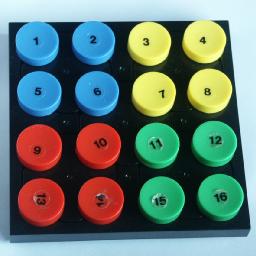



This simple puzzle has numbered and coloured pieces arranged in a 4×4 square. The pieces can be mixed up by rotating a 2×2 sub-square of pieces - either a corner square or the centre square. The aim is of course to unscramble the pieces, restoring the starting position. It is also possible to ignore the numbers and just make a particular arrangement of the colours.
The original version of Gripple was marketed by M-Squared Inc. in 1989. There are 4 colours, with four pieces of each. In the solved position, the four pieces of a colour are together in a 2x2 square. A sheet of numbered stickers was supplied with it so that the pieces could be numbered 1 to 16 in any manner you wanted. In Taiwan this puzzle was also made with numbers printed onto the pieces.
Gripple was invented by Murray J. Gould, and patented on 5 April 1988, US 4,735,417.
There is also a Bulgarian version of the puzzle, shown in the second picture above, which is called Colour Spectre, or Gamma. It has 5 knobs on the back of the puzzle with which you turn the sub-squares of pieces. The pieces are encased in a frame with 16 holes that allow the numbers to be seen. Most commonly it has four colours of pieces, four pieces of each colour that are numbered 1 to 4. There are also versions where all the pieces are the same colour and numbered 1 to 16. It comes in many different colour combinations.
If your browser supports JavaScript, then you can play Gripple by clicking the link below:
There are 16 pieces, so these can be arranged in at most 16! ways, and in fact all these can in fact be reached. The orientation of the pieces is completely determined by their position, so there are 16! = 20,922,789,888,000 possible positions. Note however that there is more than one solution, as the puzzle can be solved in any of the four orientations, so there are 4 solutions. Furthermore in the Bulgarian version, the 4 colours can be arranged in 4! ways in the solution, which means that is has 4·4! = 96 solutions.
Phase 1: Solve the three edge pieces of the top left square.
Phase 2: Solve all the other edge pieces.
The edge pieces of the other corners can be solved in the same way. You can simply turn the
whole puzzle so that an unsolved corner is at the top left and go through phase 1 to solve
it. Do this for each corner.
Phase 3: Solve the centre.